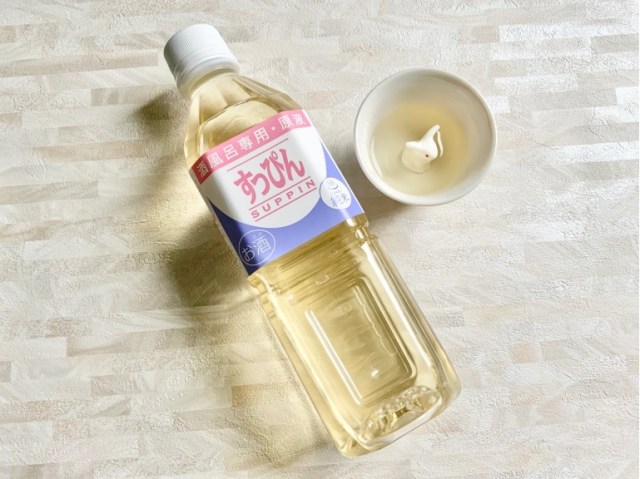
Suppin doesn’t have a place at the table, but it’s definitely got a spot in our home now.
The Fukumitsuya sake brewery was founded in the town of Kanazawa all the way back in 1625. In the time since, they’ve released a wide range of brews, but we recently came across what’s arguably the most unique variety of sake they’ve created in the nearly four centuries they’ve been in business.
It’s called Suppin, and right away you can see something is different about it. Most sake is sold in glass bottles, helping it look elegant and stately on your table between cup-refilling pours, but Suppin comes in a plastic bottle instead, like the kind used for bottled water or tea.
This isn’t because Suppin is a cheap or super-casual sake, though. It’s because the bottle isn’t going to be sitting on your table, or even in the dining room at all, really. It’s not even going to go into your sake cup – it’s going to go into your bathtub.
Suppin’s name is a hint to its true purpose, as suppin means “face with no makeup,” and by extension has the connotation of “bare skin.” Japanese folk wisdom has long held that bathing in sake is suppose to help smooth the skin and warm the body, and so Fukumitsuya decided to make a sake specifically for that use. This is, however, still sake, with the legal classification of seishu, or “clear sake,” designated on its label.
▼ 清酒 / seishu
Even though it’s not meant for drinking, our Japanese-language reporter Natsuki Gojo was still curious as to how Suppin would look in a sake cup, so she did a quick test pour.
▼ Yes, Natsuki’s sake cup does have a ceramic bunny built into it.
Not only does it look like sake, it smells like it too, with that enticing subtly sweet and sharp aroma of Japanese rice wine. Of course, this all makes sense since, again, Suppin is sake, not just some sort of sake-themed liquified bath salt.
The directions recommend using 250 milliliters (8.5 ounces), or half the bottle, per 200 liters of bathwater, which works out to roughly the entire 500-milliliter bottle for a full adult-sized tub. After Natsuki drew herself a bath, she poured in the Suppin, giving the tub several sweeping stirs with her arm to mix everything together nicely.
Visually, adding the Suppin didn’t change much, as you can see in the before/after photos above. Given how fragrant the sake had been in her cup, Natsuki was worried that the hot water would boost the power of the fragrance and make it smell like she’d spilled a bottle of booze in the bathroom, but thankfully that didn’t happen. On the contrary, mixing Suppin with the bathwater seemed to mellow out its bouquet, giving a soft, subtle hint of sake scent free of the harsher alcohol notes. Basically, unless you’re someone who strongly dislikes the smell of sake, you’ll be fine, and if you’re someone who does like the smell of sake, you’ll be happy. Fukumitsuya also says that when mixed with the recommended amount of bathwater, the alcoholic content of the mixture becomes just 0.02 percent, making a Suppin bath safe for bathers of al ages.
With her bath fully prepared, Natsuki hopped in for a nice long soak. And did Suppin provide the benefits a sake bath is supposed to, more warmth and soother skin? Natsuki says yes to both.
Even while she was still soaking, Natsuki felt like her core was getting warmer than it usually does, and this sensation continued even after she got out of the tub. In Japanese, there’s a term, “yuzame,” that refers to that chill you experience after getting out of the bath as your body reverts to regular room temperature. After her Suppin bath, though, this didn’t happen to Natsuki at all, as her bath’s warmth lingered long enough for a smooth, cozy transition. As for her skin, while a single bath isn’t enough to gauge long-term benefits, it definitely felt smooth and moist even after she’d toweled off.
Our 500-milliliter bottle of Suppin cost 721 yen (US$5.80), but Fukumitsuya has both larger and smaller sizes, as well as bulk packs, available through both its online shop and Amazon here.
Photos © SoraNews24
● Want to hear about SoraNews24’s latest articles as soon as they’re published? Follow us on Facebook and Twitter!
[ Read in Japanese ]
Follow Casey on Twitter, where he could use a bath and a drink.